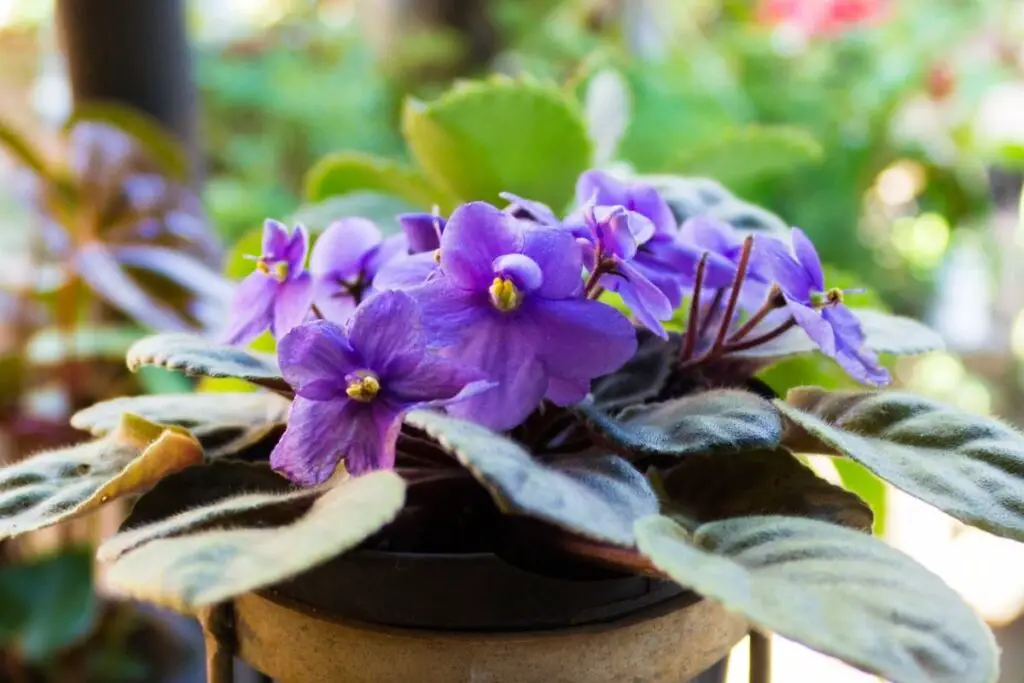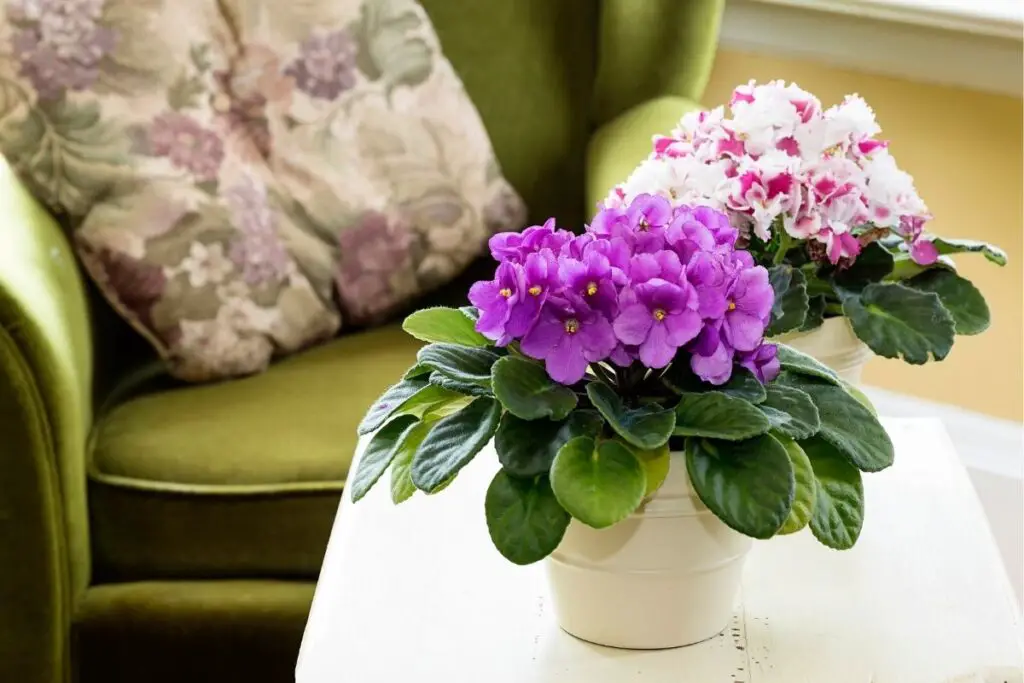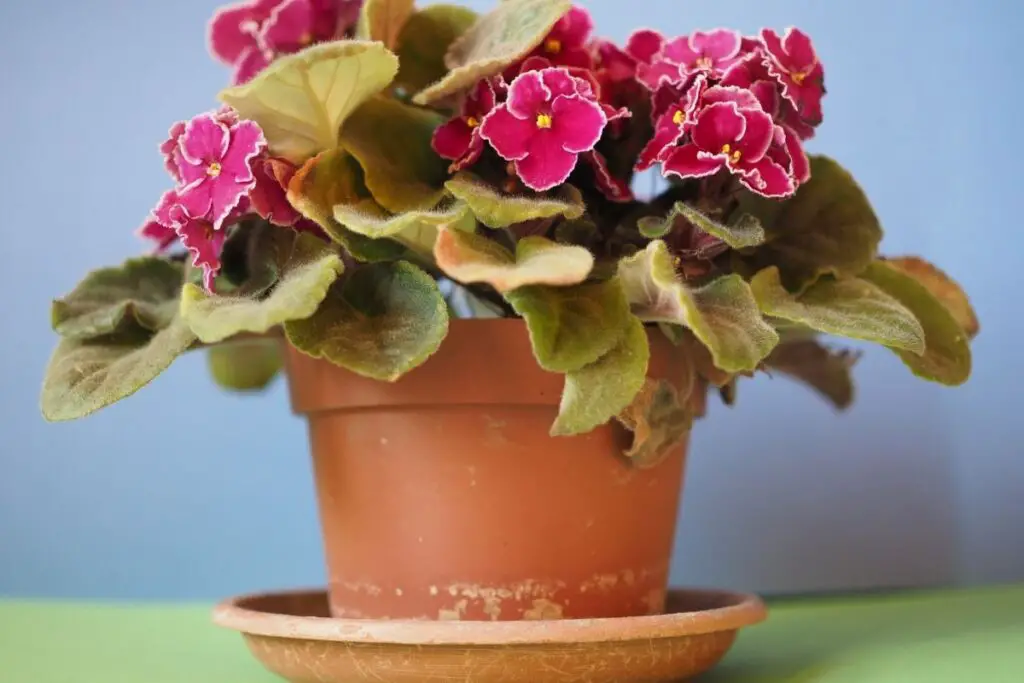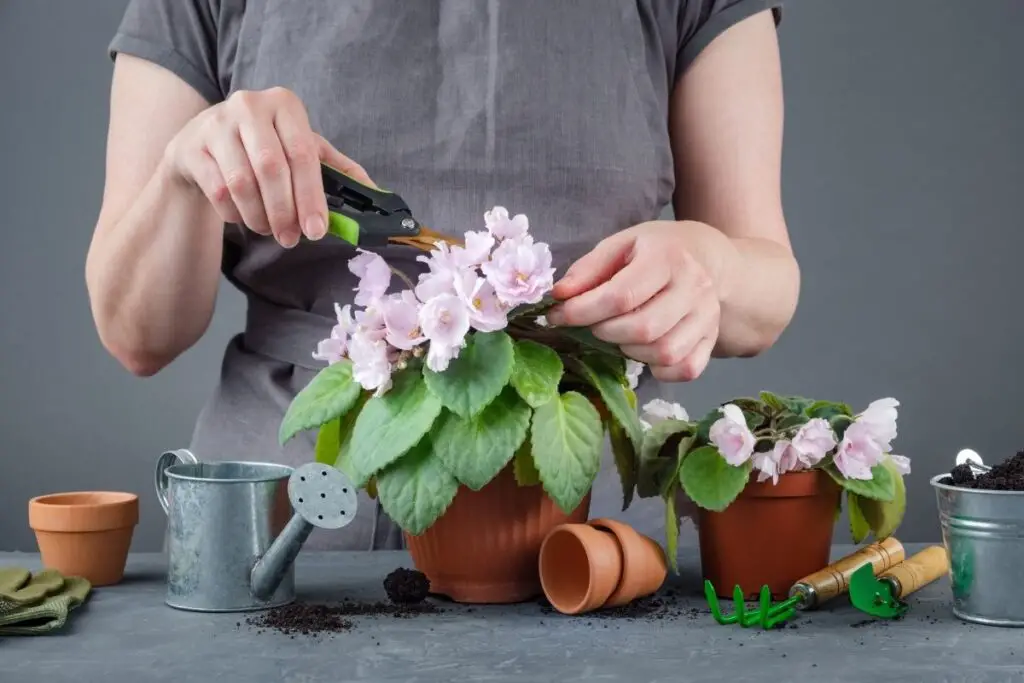African violets are native to the tropical rainforests of Africa. They are common indoor plants or houseplants, but they can also be grown outdoors under favorable climatic conditions. These plants prefer to remain warm, so during winter, they need special attention.
So, in this article, we will discuss how to take care of African violets in the winter?
You need to follow these steps to care for African violets during the winters:
- Provide enough bright indirect sunlight or use artificial light to supplement the natural lighting.
- Water less frequently and let the soil slightly dry out between watering.
- Use room temperature water while watering your African violets.
- If you live in a zone where winter is harsh, then lower the dosage of fertilizer or stop fertilizing altogether.
- Improve the humidity around your African violets.
- Maintain a temperature between 65-80°F.
- Protect the plant from cold drafts.
Caring for your African violet requires minimal effort, i.e., they are generally easy to care for, but winter might be a difficult time as these plants don’t enjoy low temperatures. In this article, we will discuss winter care for the African violets in detail.

Common problems of African violets during winter
During winter, the growth slows down, and the plants go dormant. Those new to African violet plants might find it challenging to understand the reasons behind the problems seen during the winter season.
There are many problems that your African violet plant might be facing during the winter months. Some of which are:
- Insufficient sunlight
- Over-watering
- Over-fertilization
- Leggy plants
- Leaf dropping due to cold drafts
How do you take care of African violets in the winter?
If you provide the ideal growing conditions to your African violet plant even during winter, you will be able to keep it healthy. You will notice beautiful flowers and healthy leaves.
These are some of the points one should remember while growing African violets during winter:
Looking for gardening supplies? We have tested 100's of products before recommending them to you guys. Check out our best pick below:
| Image | Gardening Supplies | Best Price? |
|---|---|---|
 Top
Top Top
Top | Raised Garden Bed Kit | Check On Amazon |
 | XLUX Soil Moisture Meter, Plant Water Monitor, Soil Hygrometer Sensor for Gardening, Farming, Indoor and Outdoor Plants, No Batteries Required | No Results |
 Top
Top Top
Top | 82 Pcs Garden Tools Set and Extra Succulent Tools Set | Check On Amazon |
 | Joeys Garden Expandable Garden Hose with 8 Function Hose Nozzle, Lightweight Anti-Kink Flexible Garden Hoses, Extra Strength Fabric with Double Latex Core, (50 FT, Black) | No Results |
 Top
Top Top
Top | Dual Chamber Compost Tumbler | Check On Amazon |
 Top
Top Top
Top | Sunnyglade Plant Stakes | Check On Amazon |
 Top
Top Top
Top | Organic Cold Pressed Neem Seed Oil | Check On Amazon |
 Top
Top Top
Top | Mighty Mint Gallon :-Insect and Pest Control Peppermint Oil | Check On Amazon |
 Top
Top Top
Top | Scotts DiseaseEx Lawn Fungicide | Check On Amazon |
 Top
Top Top
Top | Jacks Classic 20-20-20 All Purpose Fertilizer | Check On Amazon |
 Top
Top Top
Top | 30,000 Seeds Pollinator Attracting Wildflower Mixture | Check On Amazon |
 Top
Top Top
Top | Survival Vegetable Seeds Garden Kit-Over 16,000 Seeds | Check On Amazon |
Sunlight

African violets are native to the rainforests in Tanzania, where there is enough shaded light for their growth. To grow the African violets at home or in your garden, you need to provide similar conditions to the plant so that they remain healthy.
For growing African violets successfully during the winter season, you need to choose a proper spot since direct sunlight can harm the plant even during the winter months. For blooming, African violets need up to 16 hours of light, and they also need 8 hours of darkness.
The sun’s light intensity and duration go down significantly during the winter months, and the plants do not get sufficient sunlight. As a result, their growth is hampered. Hence you can provide artificial lighting to grow the African violets.
You can use fluorescent bulbs as a great source of artificial light. Fluorescent bulbs are also less expensive and produce less heat.
You can provide light by suspending two 40-watt fluorescent tubes 12 to 15 inches above the plants for 16 hours per day.
Commercial lighting systems, also known as “grow lights,” are also used as a source of artificial lighting for plants. Hence extending the daylight by placing the African violets under a grow light during winter can help keep the plant healthy and blooming.
If your African violet plant has dust on its leaves, you need to clean it so that the dust might not hinder the plant’s functions.
Also read: What Kind Of Light Does An African Violet Need? (African Violet Light Requirements)
Watering
During winter, the plants remain dormant, and you should not water them regularly. Due to less light, the soil takes time to dry up, and therefore, the water requirement is less than the other months of the year.
If the water temperature is colder or warmer than your plant’s base temperature, it can shock and kill the plant’s cells.
If cold water touches relatively warm leaves, it can cause yellowish streaks and spots on the upper surface of the leaves.
Always ensure that the water temperature is the same or slightly warmer than the plant’s base temperature.
If you are watering from the top, try not to get water onto the leaves while the plant is kept in the sun because this can lead to leaf spots and turn the leaves brown.
Do not allow the African violets to sit in water indefinitely because this can lead to the deterioration of the plant. Do not overwater. Keep the soil lightly moist as the African violets have soft stems that are susceptible to root rot.
Also read: How Often Should African Violets Be Watered? (African Violet Water Requirements)
Temperature
African violets prefer warm temperatures, i.e., they grow satisfactorily at temperatures between 70-80°F during the day & around 65-70°F at night.
If the temperature gets too cold, the African violets stop blooming, and their growth gets stunted. The plant goes into shock in more severe cases, and its leaves and flowers begin to wilt.
If the cold weather is accompanied by excess moisture, the chances of being attacked by pathogens and cause crown rot.
Water temperature becomes very important during the winter months as cold water directly on the leaves will damage them quickly.
If you reside in a freezing area, you should place your potted African violet inside the house and away from the window to resist the cold wind. You can also cover the pot using cling wraps.
Also read: Can African Violets Grow Outside? (+Outdoor Care)
Humidity

Since African violets are tropical plants, they prefer a humid environment for their growth. During winter, the climate lacks humidity which acts as a big problem for African violets.
Due to low humidity, the leaves tend to develop brown edges, and the plants begin to wilt and droop. The leaves start turning yellow, and the foliage becomes crispy.
Several methods are practiced to deal with low humidity:
- Use pebble trays – Pebble trays can be easily constructed by placing a layer of pebbles and then adding water to the tray. After that, place the African violet on it. When the water evaporates, the moisture content in the air increases.
- Use a humidifier – Humidifier is a device that can retain moisture, which is beneficial for the plant’s growth during the winter season.
- Containers with water – You can put water in some containers and place those around your plants. The water will evaporate and add humidity around those.
Also read: Do African Violets Like Misting? (+Humidity Guide)
Fertilization
During the winter months, the African violets do not need fertilizers. Giving the plant a high amount of fertilizers can cause severe damage to the plant.
Many new plant owners add fertilizers to their African violet plant even during the winters, which is a mistake.
Fertilizing the African violets during the winter season should be avoided. The best time to add fertilizers to the African violets is in the spring season when the plant is actively growing & blooming.
Providing excess fertilizers can cause severe problems that can be fatal.
Over-fertilized African violets develop tight centers, and the leaves darken on the tip, referred to as leaf tip burn, and are visibly brown.
You must rinse the plant and the pot with lukewarm water until the orange crystals dissolve and wash away.
To prevent these problems, you should examine the rim of the pots regularly. The concentration of fertilizer salts present on the rim of the pot is an indication of over-fertilizing.
Also, you should use a fertilizer that has been specifically formulated for the African violets.
Also read: What Kind Of Fertilizer Is Good For African Violets? (+Best Picks)
Pruning

Pruning is the technique of removal of any part of the plant which is unwanted. During the winter months, a lot of leggy growth is observed in these plants.
The best thing about African violets is that you can prune them at any time of the year, including the winter, unlike many other plants.
To trim these leggy growths, you can use sharp and sterilized scissors. The aim of pruning the African violets is the removal of dead, damaged leaves and spent flowers.
African violets winter care tips
After taking care of the bare winter requirements of your African violets, these extra tips can help you avoid making mistakes during winter.
- Put a plastic cover on your African violets growing in the garden to protect them from cold drafts and low temperatures. This will also help to trap some humidity inside.
- For potted African violets, avoid repotting during winter as that can shock the plant. Avoid transplanting the ones growing in the garden unless there is some severe issue such as root rot.
- You can get a small greenhouse for your African violets to help them survive the winter. These are available online, so you can purchase one and use it in your garden or house. You can also create a DIY greenhouse yourself if you don’t want to buy one.
- Avoid using chlorinated or soft water on your African violets as these will be harmful to them.
- Move your African violet to a warm place if it has got affected due to cold temperatures. If you are growing African violets in the garden, try to locate a spot that can provide more warmth to the plants and move them to that spot.
- Place a clear plastic bag on the plants and close the mouth of the plastic with a wire. You might notice signs of recovery within few days. You must keep the plant in the bag for at least a week.
- If the African violets are getting light from grow lights, and you notice that some leaves have lighter shaded spots on them, the light is not suitable, and you need to stop exposing your African violets to grow lights.
Source: Wikipedia, African violet: Classical breeding, African Violet Society of America, In vitro propagation of African violet, University of Florida, North Dakota State University, The University of Georgia.
